HND BSE: Management Principles & Application in Construction Sector
VerifiedAdded on 2023/04/23
|37
|11226
|420
Report
AI Summary
This report discusses management principles and processes applicable to the construction and built environment sector, with a focus on the Hong Kong context. It elaborates on the importance of human resource management in influencing employee performance, the activities and structures within the construction industry, and the impact of organizational structure and contract size. The report also covers planning, procurement control, scheduling, quality and risk management, and different procurement methods, analyzing their impact on construction firms. It highlights the essential management functions of organizing, controlling, leading, and planning, alongside principles such as division of work, authority, unity of command, scheduling, remuneration, order, equity, unity of direction, centralization, and scalar chain, emphasizing their role in effective construction management.
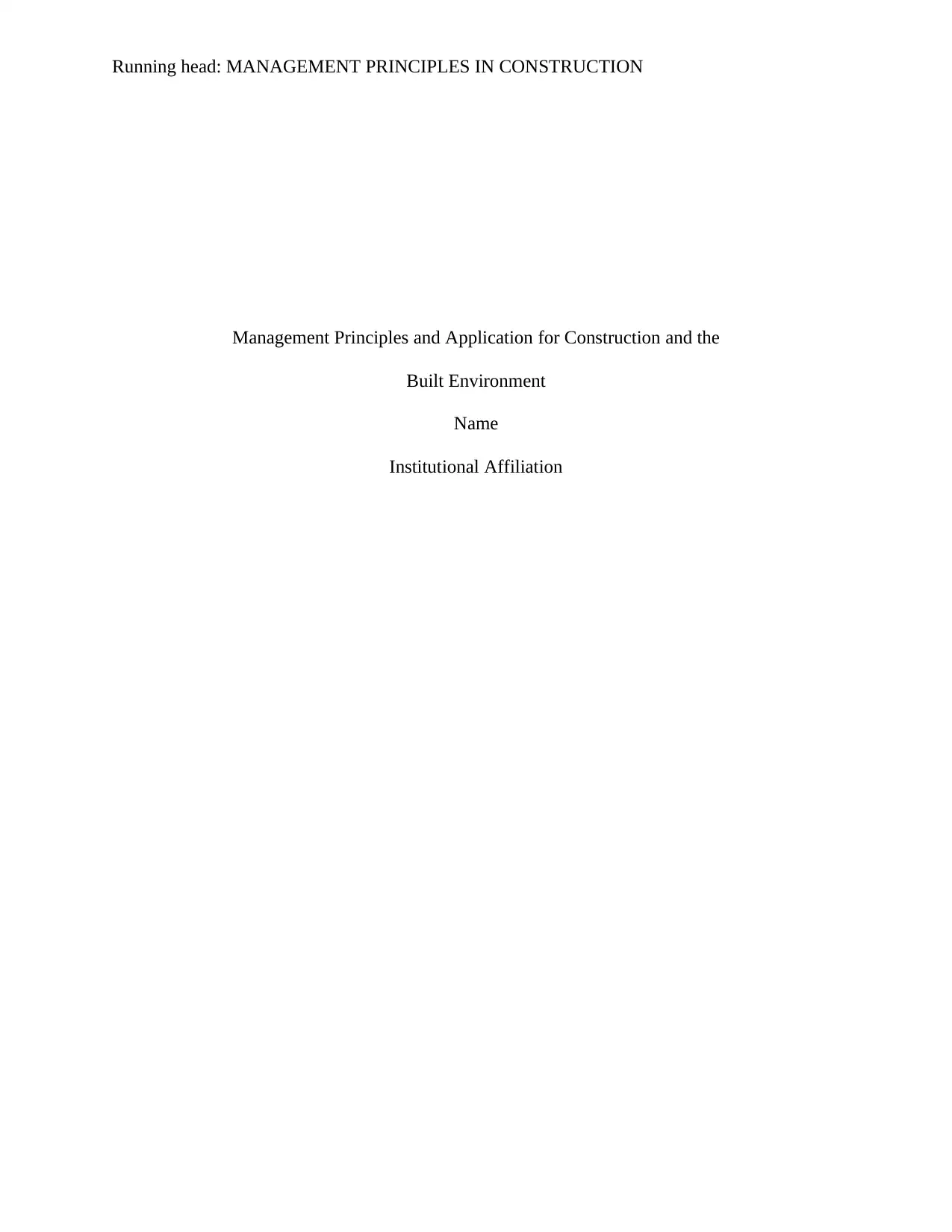
Running head: MANAGEMENT PRINCIPLES IN CONSTRUCTION
Management Principles and Application for Construction and the
Built Environment
Name
Institutional Affiliation
Management Principles and Application for Construction and the
Built Environment
Name
Institutional Affiliation
Paraphrase This Document
Need a fresh take? Get an instant paraphrase of this document with our AI Paraphraser
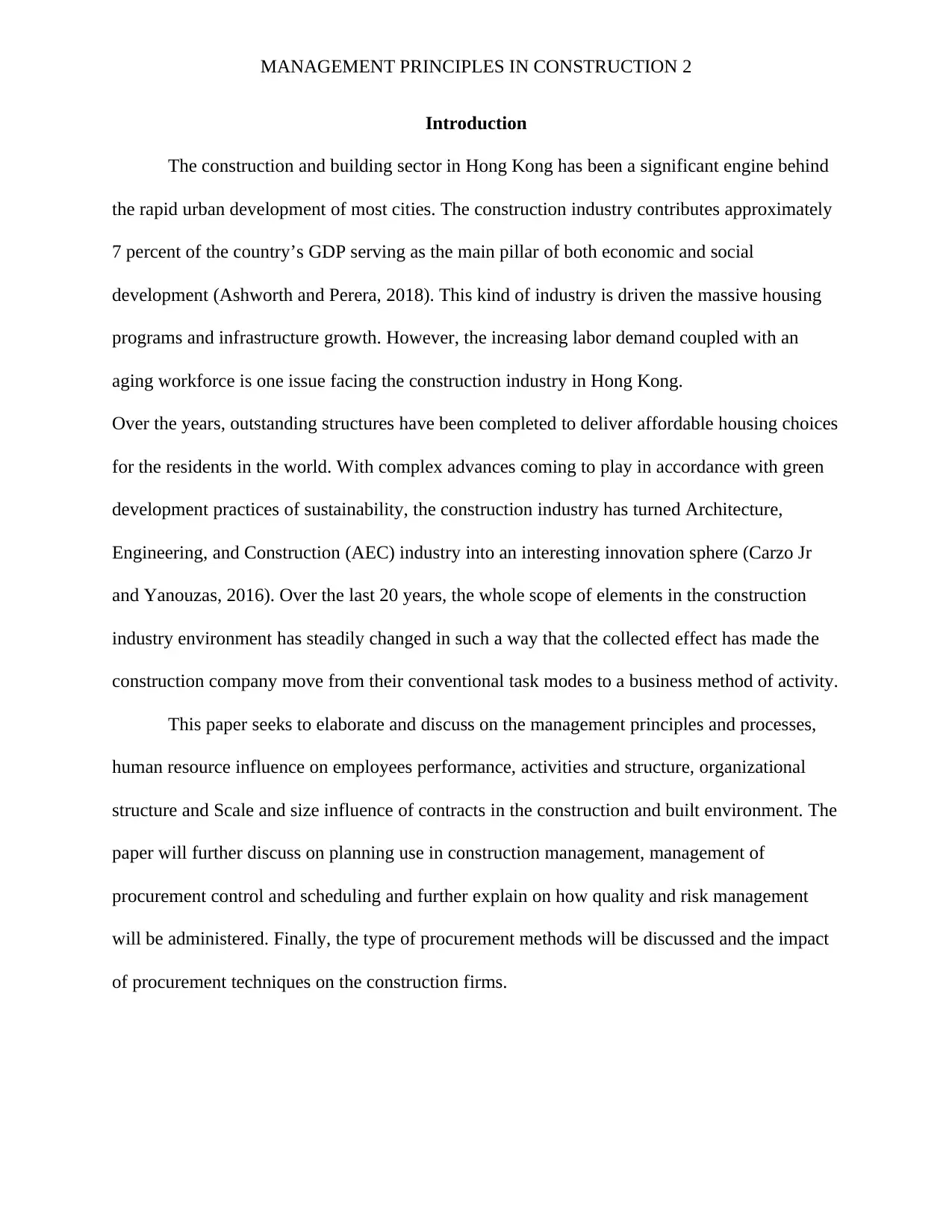
MANAGEMENT PRINCIPLES IN CONSTRUCTION 2
Introduction
The construction and building sector in Hong Kong has been a significant engine behind
the rapid urban development of most cities. The construction industry contributes approximately
7 percent of the country’s GDP serving as the main pillar of both economic and social
development (Ashworth and Perera, 2018). This kind of industry is driven the massive housing
programs and infrastructure growth. However, the increasing labor demand coupled with an
aging workforce is one issue facing the construction industry in Hong Kong.
Over the years, outstanding structures have been completed to deliver affordable housing choices
for the residents in the world. With complex advances coming to play in accordance with green
development practices of sustainability, the construction industry has turned Architecture,
Engineering, and Construction (AEC) industry into an interesting innovation sphere (Carzo Jr
and Yanouzas, 2016). Over the last 20 years, the whole scope of elements in the construction
industry environment has steadily changed in such a way that the collected effect has made the
construction company move from their conventional task modes to a business method of activity.
This paper seeks to elaborate and discuss on the management principles and processes,
human resource influence on employees performance, activities and structure, organizational
structure and Scale and size influence of contracts in the construction and built environment. The
paper will further discuss on planning use in construction management, management of
procurement control and scheduling and further explain on how quality and risk management
will be administered. Finally, the type of procurement methods will be discussed and the impact
of procurement techniques on the construction firms.
Introduction
The construction and building sector in Hong Kong has been a significant engine behind
the rapid urban development of most cities. The construction industry contributes approximately
7 percent of the country’s GDP serving as the main pillar of both economic and social
development (Ashworth and Perera, 2018). This kind of industry is driven the massive housing
programs and infrastructure growth. However, the increasing labor demand coupled with an
aging workforce is one issue facing the construction industry in Hong Kong.
Over the years, outstanding structures have been completed to deliver affordable housing choices
for the residents in the world. With complex advances coming to play in accordance with green
development practices of sustainability, the construction industry has turned Architecture,
Engineering, and Construction (AEC) industry into an interesting innovation sphere (Carzo Jr
and Yanouzas, 2016). Over the last 20 years, the whole scope of elements in the construction
industry environment has steadily changed in such a way that the collected effect has made the
construction company move from their conventional task modes to a business method of activity.
This paper seeks to elaborate and discuss on the management principles and processes,
human resource influence on employees performance, activities and structure, organizational
structure and Scale and size influence of contracts in the construction and built environment. The
paper will further discuss on planning use in construction management, management of
procurement control and scheduling and further explain on how quality and risk management
will be administered. Finally, the type of procurement methods will be discussed and the impact
of procurement techniques on the construction firms.
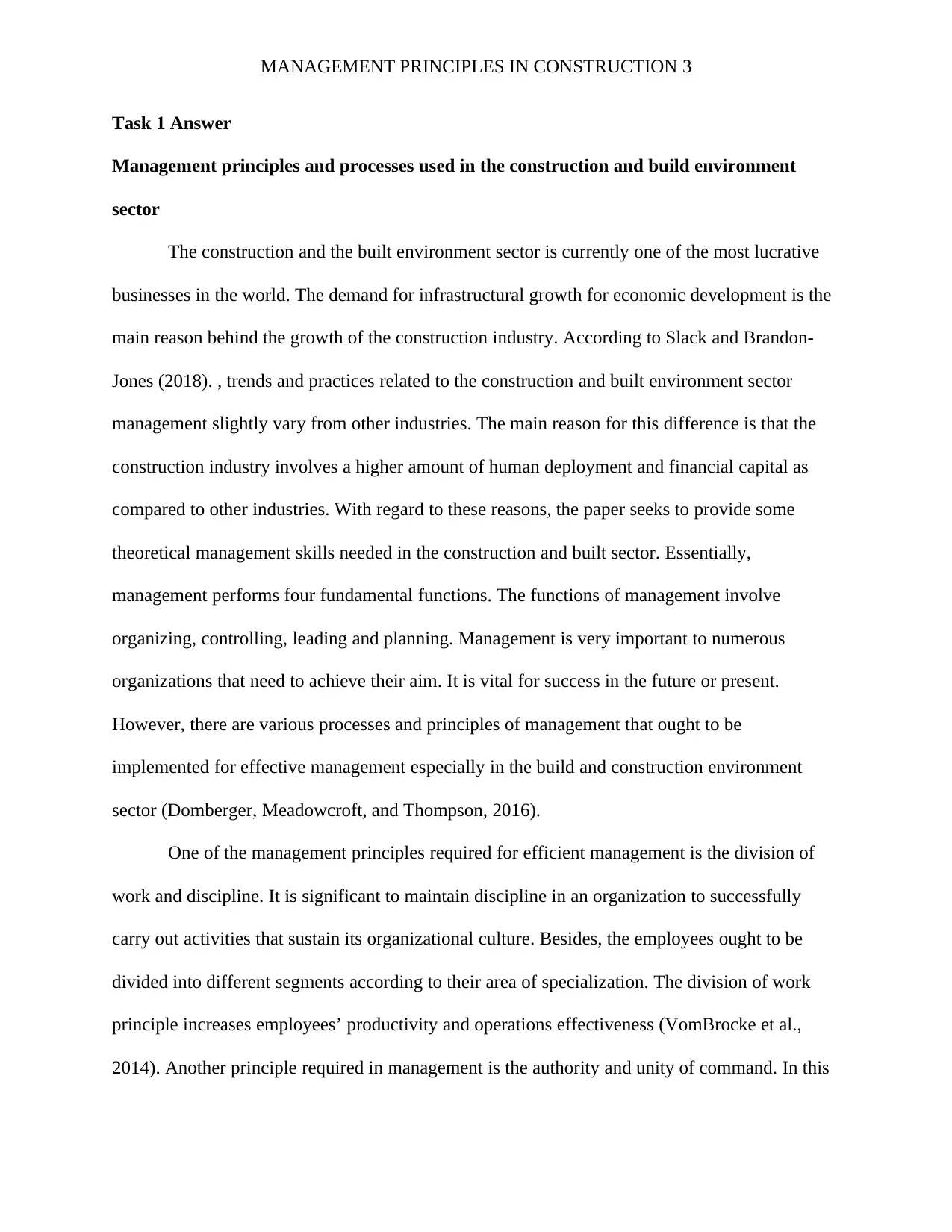
MANAGEMENT PRINCIPLES IN CONSTRUCTION 3
Task 1 Answer
Management principles and processes used in the construction and build environment
sector
The construction and the built environment sector is currently one of the most lucrative
businesses in the world. The demand for infrastructural growth for economic development is the
main reason behind the growth of the construction industry. According to Slack and Brandon-
Jones (2018). , trends and practices related to the construction and built environment sector
management slightly vary from other industries. The main reason for this difference is that the
construction industry involves a higher amount of human deployment and financial capital as
compared to other industries. With regard to these reasons, the paper seeks to provide some
theoretical management skills needed in the construction and built sector. Essentially,
management performs four fundamental functions. The functions of management involve
organizing, controlling, leading and planning. Management is very important to numerous
organizations that need to achieve their aim. It is vital for success in the future or present.
However, there are various processes and principles of management that ought to be
implemented for effective management especially in the build and construction environment
sector (Domberger, Meadowcroft, and Thompson, 2016).
One of the management principles required for efficient management is the division of
work and discipline. It is significant to maintain discipline in an organization to successfully
carry out activities that sustain its organizational culture. Besides, the employees ought to be
divided into different segments according to their area of specialization. The division of work
principle increases employees’ productivity and operations effectiveness (VomBrocke et al.,
2014). Another principle required in management is the authority and unity of command. In this
Task 1 Answer
Management principles and processes used in the construction and build environment
sector
The construction and the built environment sector is currently one of the most lucrative
businesses in the world. The demand for infrastructural growth for economic development is the
main reason behind the growth of the construction industry. According to Slack and Brandon-
Jones (2018). , trends and practices related to the construction and built environment sector
management slightly vary from other industries. The main reason for this difference is that the
construction industry involves a higher amount of human deployment and financial capital as
compared to other industries. With regard to these reasons, the paper seeks to provide some
theoretical management skills needed in the construction and built sector. Essentially,
management performs four fundamental functions. The functions of management involve
organizing, controlling, leading and planning. Management is very important to numerous
organizations that need to achieve their aim. It is vital for success in the future or present.
However, there are various processes and principles of management that ought to be
implemented for effective management especially in the build and construction environment
sector (Domberger, Meadowcroft, and Thompson, 2016).
One of the management principles required for efficient management is the division of
work and discipline. It is significant to maintain discipline in an organization to successfully
carry out activities that sustain its organizational culture. Besides, the employees ought to be
divided into different segments according to their area of specialization. The division of work
principle increases employees’ productivity and operations effectiveness (VomBrocke et al.,
2014). Another principle required in management is the authority and unity of command. In this
⊘ This is a preview!⊘
Do you want full access?
Subscribe today to unlock all pages.

Trusted by 1+ million students worldwide
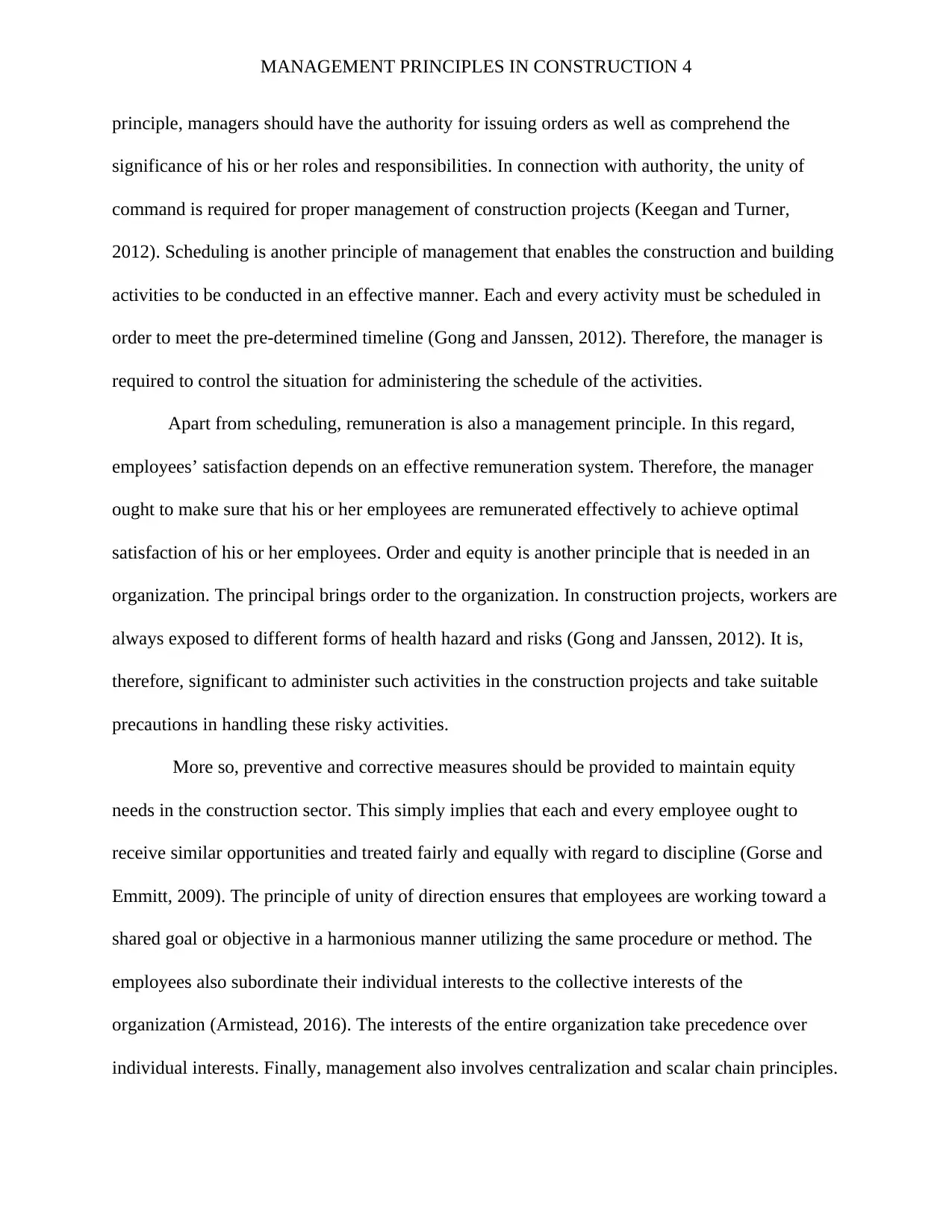
MANAGEMENT PRINCIPLES IN CONSTRUCTION 4
principle, managers should have the authority for issuing orders as well as comprehend the
significance of his or her roles and responsibilities. In connection with authority, the unity of
command is required for proper management of construction projects (Keegan and Turner,
2012). Scheduling is another principle of management that enables the construction and building
activities to be conducted in an effective manner. Each and every activity must be scheduled in
order to meet the pre-determined timeline (Gong and Janssen, 2012). Therefore, the manager is
required to control the situation for administering the schedule of the activities.
Apart from scheduling, remuneration is also a management principle. In this regard,
employees’ satisfaction depends on an effective remuneration system. Therefore, the manager
ought to make sure that his or her employees are remunerated effectively to achieve optimal
satisfaction of his or her employees. Order and equity is another principle that is needed in an
organization. The principal brings order to the organization. In construction projects, workers are
always exposed to different forms of health hazard and risks (Gong and Janssen, 2012). It is,
therefore, significant to administer such activities in the construction projects and take suitable
precautions in handling these risky activities.
More so, preventive and corrective measures should be provided to maintain equity
needs in the construction sector. This simply implies that each and every employee ought to
receive similar opportunities and treated fairly and equally with regard to discipline (Gorse and
Emmitt, 2009). The principle of unity of direction ensures that employees are working toward a
shared goal or objective in a harmonious manner utilizing the same procedure or method. The
employees also subordinate their individual interests to the collective interests of the
organization (Armistead, 2016). The interests of the entire organization take precedence over
individual interests. Finally, management also involves centralization and scalar chain principles.
principle, managers should have the authority for issuing orders as well as comprehend the
significance of his or her roles and responsibilities. In connection with authority, the unity of
command is required for proper management of construction projects (Keegan and Turner,
2012). Scheduling is another principle of management that enables the construction and building
activities to be conducted in an effective manner. Each and every activity must be scheduled in
order to meet the pre-determined timeline (Gong and Janssen, 2012). Therefore, the manager is
required to control the situation for administering the schedule of the activities.
Apart from scheduling, remuneration is also a management principle. In this regard,
employees’ satisfaction depends on an effective remuneration system. Therefore, the manager
ought to make sure that his or her employees are remunerated effectively to achieve optimal
satisfaction of his or her employees. Order and equity is another principle that is needed in an
organization. The principal brings order to the organization. In construction projects, workers are
always exposed to different forms of health hazard and risks (Gong and Janssen, 2012). It is,
therefore, significant to administer such activities in the construction projects and take suitable
precautions in handling these risky activities.
More so, preventive and corrective measures should be provided to maintain equity
needs in the construction sector. This simply implies that each and every employee ought to
receive similar opportunities and treated fairly and equally with regard to discipline (Gorse and
Emmitt, 2009). The principle of unity of direction ensures that employees are working toward a
shared goal or objective in a harmonious manner utilizing the same procedure or method. The
employees also subordinate their individual interests to the collective interests of the
organization (Armistead, 2016). The interests of the entire organization take precedence over
individual interests. Finally, management also involves centralization and scalar chain principles.
Paraphrase This Document
Need a fresh take? Get an instant paraphrase of this document with our AI Paraphraser
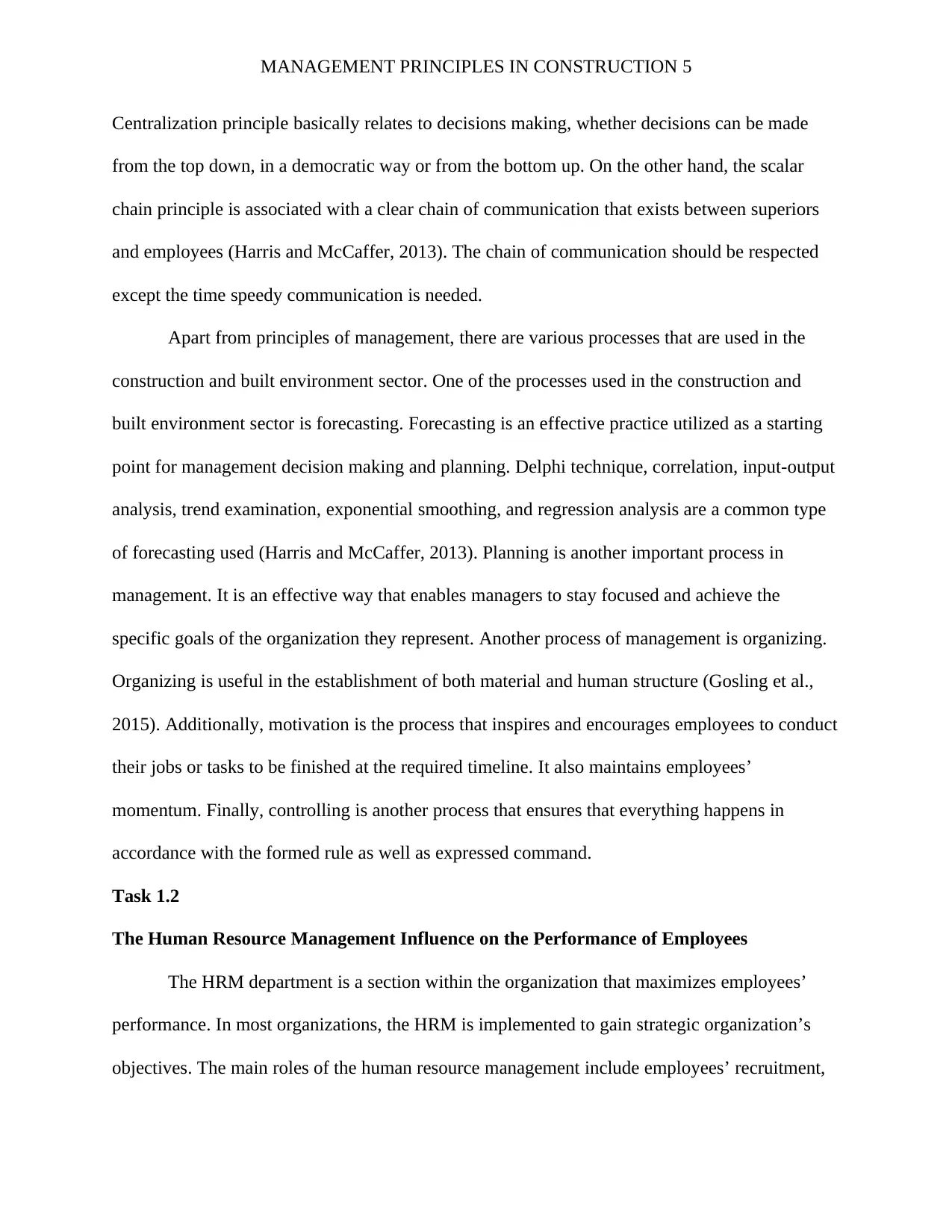
MANAGEMENT PRINCIPLES IN CONSTRUCTION 5
Centralization principle basically relates to decisions making, whether decisions can be made
from the top down, in a democratic way or from the bottom up. On the other hand, the scalar
chain principle is associated with a clear chain of communication that exists between superiors
and employees (Harris and McCaffer, 2013). The chain of communication should be respected
except the time speedy communication is needed.
Apart from principles of management, there are various processes that are used in the
construction and built environment sector. One of the processes used in the construction and
built environment sector is forecasting. Forecasting is an effective practice utilized as a starting
point for management decision making and planning. Delphi technique, correlation, input-output
analysis, trend examination, exponential smoothing, and regression analysis are a common type
of forecasting used (Harris and McCaffer, 2013). Planning is another important process in
management. It is an effective way that enables managers to stay focused and achieve the
specific goals of the organization they represent. Another process of management is organizing.
Organizing is useful in the establishment of both material and human structure (Gosling et al.,
2015). Additionally, motivation is the process that inspires and encourages employees to conduct
their jobs or tasks to be finished at the required timeline. It also maintains employees’
momentum. Finally, controlling is another process that ensures that everything happens in
accordance with the formed rule as well as expressed command.
Task 1.2
The Human Resource Management Influence on the Performance of Employees
The HRM department is a section within the organization that maximizes employees’
performance. In most organizations, the HRM is implemented to gain strategic organization’s
objectives. The main roles of the human resource management include employees’ recruitment,
Centralization principle basically relates to decisions making, whether decisions can be made
from the top down, in a democratic way or from the bottom up. On the other hand, the scalar
chain principle is associated with a clear chain of communication that exists between superiors
and employees (Harris and McCaffer, 2013). The chain of communication should be respected
except the time speedy communication is needed.
Apart from principles of management, there are various processes that are used in the
construction and built environment sector. One of the processes used in the construction and
built environment sector is forecasting. Forecasting is an effective practice utilized as a starting
point for management decision making and planning. Delphi technique, correlation, input-output
analysis, trend examination, exponential smoothing, and regression analysis are a common type
of forecasting used (Harris and McCaffer, 2013). Planning is another important process in
management. It is an effective way that enables managers to stay focused and achieve the
specific goals of the organization they represent. Another process of management is organizing.
Organizing is useful in the establishment of both material and human structure (Gosling et al.,
2015). Additionally, motivation is the process that inspires and encourages employees to conduct
their jobs or tasks to be finished at the required timeline. It also maintains employees’
momentum. Finally, controlling is another process that ensures that everything happens in
accordance with the formed rule as well as expressed command.
Task 1.2
The Human Resource Management Influence on the Performance of Employees
The HRM department is a section within the organization that maximizes employees’
performance. In most organizations, the HRM is implemented to gain strategic organization’s
objectives. The main roles of the human resource management include employees’ recruitment,
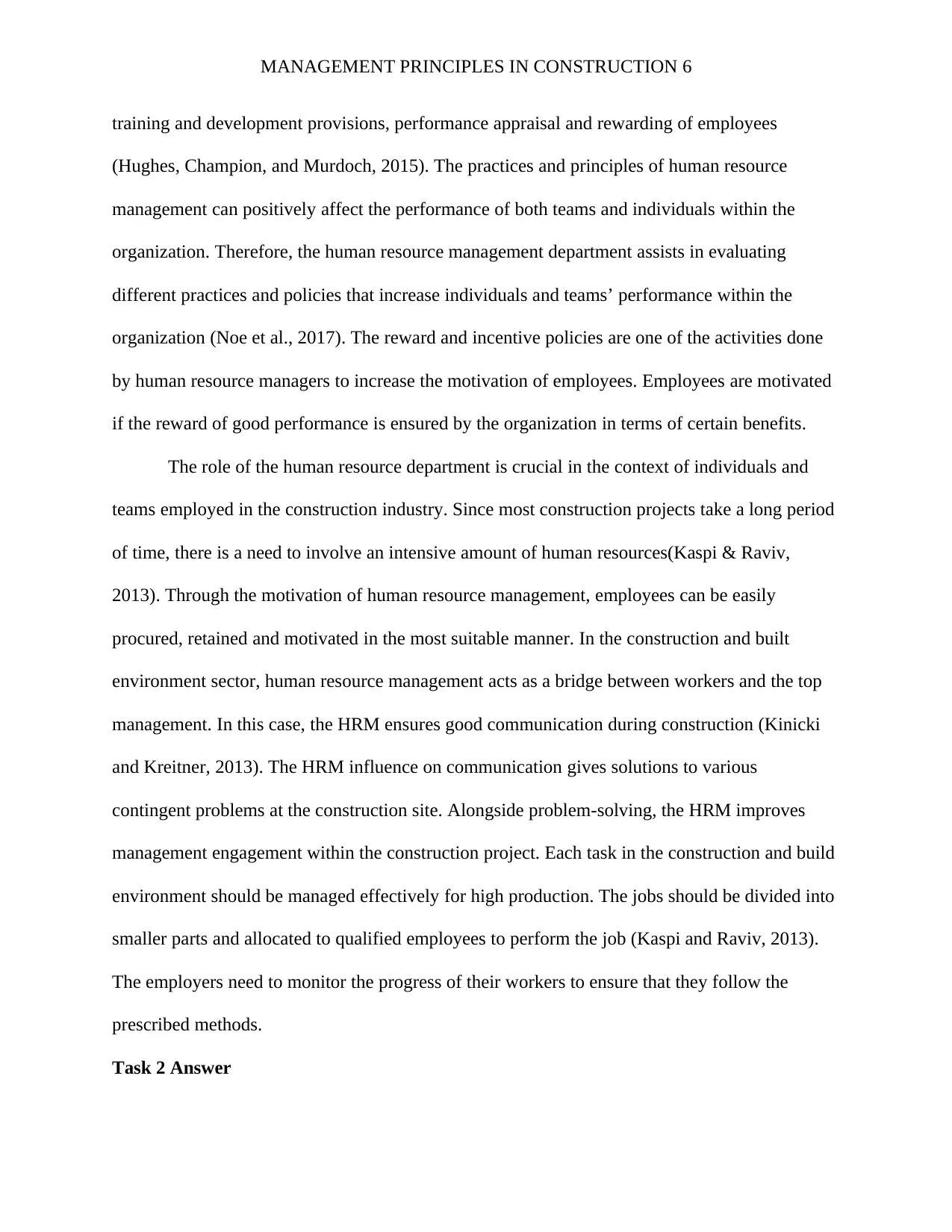
MANAGEMENT PRINCIPLES IN CONSTRUCTION 6
training and development provisions, performance appraisal and rewarding of employees
(Hughes, Champion, and Murdoch, 2015). The practices and principles of human resource
management can positively affect the performance of both teams and individuals within the
organization. Therefore, the human resource management department assists in evaluating
different practices and policies that increase individuals and teams’ performance within the
organization (Noe et al., 2017). The reward and incentive policies are one of the activities done
by human resource managers to increase the motivation of employees. Employees are motivated
if the reward of good performance is ensured by the organization in terms of certain benefits.
The role of the human resource department is crucial in the context of individuals and
teams employed in the construction industry. Since most construction projects take a long period
of time, there is a need to involve an intensive amount of human resources(Kaspi & Raviv,
2013). Through the motivation of human resource management, employees can be easily
procured, retained and motivated in the most suitable manner. In the construction and built
environment sector, human resource management acts as a bridge between workers and the top
management. In this case, the HRM ensures good communication during construction (Kinicki
and Kreitner, 2013). The HRM influence on communication gives solutions to various
contingent problems at the construction site. Alongside problem-solving, the HRM improves
management engagement within the construction project. Each task in the construction and build
environment should be managed effectively for high production. The jobs should be divided into
smaller parts and allocated to qualified employees to perform the job (Kaspi and Raviv, 2013).
The employers need to monitor the progress of their workers to ensure that they follow the
prescribed methods.
Task 2 Answer
training and development provisions, performance appraisal and rewarding of employees
(Hughes, Champion, and Murdoch, 2015). The practices and principles of human resource
management can positively affect the performance of both teams and individuals within the
organization. Therefore, the human resource management department assists in evaluating
different practices and policies that increase individuals and teams’ performance within the
organization (Noe et al., 2017). The reward and incentive policies are one of the activities done
by human resource managers to increase the motivation of employees. Employees are motivated
if the reward of good performance is ensured by the organization in terms of certain benefits.
The role of the human resource department is crucial in the context of individuals and
teams employed in the construction industry. Since most construction projects take a long period
of time, there is a need to involve an intensive amount of human resources(Kaspi & Raviv,
2013). Through the motivation of human resource management, employees can be easily
procured, retained and motivated in the most suitable manner. In the construction and built
environment sector, human resource management acts as a bridge between workers and the top
management. In this case, the HRM ensures good communication during construction (Kinicki
and Kreitner, 2013). The HRM influence on communication gives solutions to various
contingent problems at the construction site. Alongside problem-solving, the HRM improves
management engagement within the construction project. Each task in the construction and build
environment should be managed effectively for high production. The jobs should be divided into
smaller parts and allocated to qualified employees to perform the job (Kaspi and Raviv, 2013).
The employers need to monitor the progress of their workers to ensure that they follow the
prescribed methods.
Task 2 Answer
⊘ This is a preview!⊘
Do you want full access?
Subscribe today to unlock all pages.

Trusted by 1+ million students worldwide

MANAGEMENT PRINCIPLES IN CONSTRUCTION 7
Task 2.1: Activities and structures in the construction and built environment
The construction and the building sector is among the largest industry by size in the UK.
In the United Kingdom, the construction industry employs more than 3.45 million people.
Horvath (2014) indicate that the development of this sector is lucrative in terms of career
opportunity. Based on Horvath studies, the construction industry contributes to the largest
revenue in the United Kingdom. It accounts for almost 70 percent of revenue income in the
government of the UK. However, the 2008 recession contributed to the decline of construction
industry revenue from 8.9 percent to 6.7 percent (Keegan and Turner, 2012).
According to Gann (2013), the construction and the building sector is the largest industry
by size inside the United Kingdom. This industry holds almost 3.45 million peoples. The study
by Horvath (2014) reflected that the growth of this sector is very much lucrative in terms of
career opportunity. Table 1 showing orientation of the construction industry in the UK.
Sector and its specifications Services offered
Contracting offers 2.35 million job
opportunities and contribute 63 billion dollar
revenue
It offers services in specialized construction,
civil engineering and building construction
Manufacturers offer 0.31 million jobs and
contribute 13 billion dollar revenue
Manufacturers in the construction sector
produces construction materials and products
Services sector in construction offers 0.58
million jobs and contribute 14 million dollar
revenue.
It offers services for construction tool business,
construction material production and
construction tolls and material wholesaling.
Source (Horvath 2014)
The responsibilities of each sector are specific and distinguishable. The contracting sector
creates buildings, national infrastructures, and houses. The main function of the team members in
Task 2.1: Activities and structures in the construction and built environment
The construction and the building sector is among the largest industry by size in the UK.
In the United Kingdom, the construction industry employs more than 3.45 million people.
Horvath (2014) indicate that the development of this sector is lucrative in terms of career
opportunity. Based on Horvath studies, the construction industry contributes to the largest
revenue in the United Kingdom. It accounts for almost 70 percent of revenue income in the
government of the UK. However, the 2008 recession contributed to the decline of construction
industry revenue from 8.9 percent to 6.7 percent (Keegan and Turner, 2012).
According to Gann (2013), the construction and the building sector is the largest industry
by size inside the United Kingdom. This industry holds almost 3.45 million peoples. The study
by Horvath (2014) reflected that the growth of this sector is very much lucrative in terms of
career opportunity. Table 1 showing orientation of the construction industry in the UK.
Sector and its specifications Services offered
Contracting offers 2.35 million job
opportunities and contribute 63 billion dollar
revenue
It offers services in specialized construction,
civil engineering and building construction
Manufacturers offer 0.31 million jobs and
contribute 13 billion dollar revenue
Manufacturers in the construction sector
produces construction materials and products
Services sector in construction offers 0.58
million jobs and contribute 14 million dollar
revenue.
It offers services for construction tool business,
construction material production and
construction tolls and material wholesaling.
Source (Horvath 2014)
The responsibilities of each sector are specific and distinguishable. The contracting sector
creates buildings, national infrastructures, and houses. The main function of the team members in
Paraphrase This Document
Need a fresh take? Get an instant paraphrase of this document with our AI Paraphraser
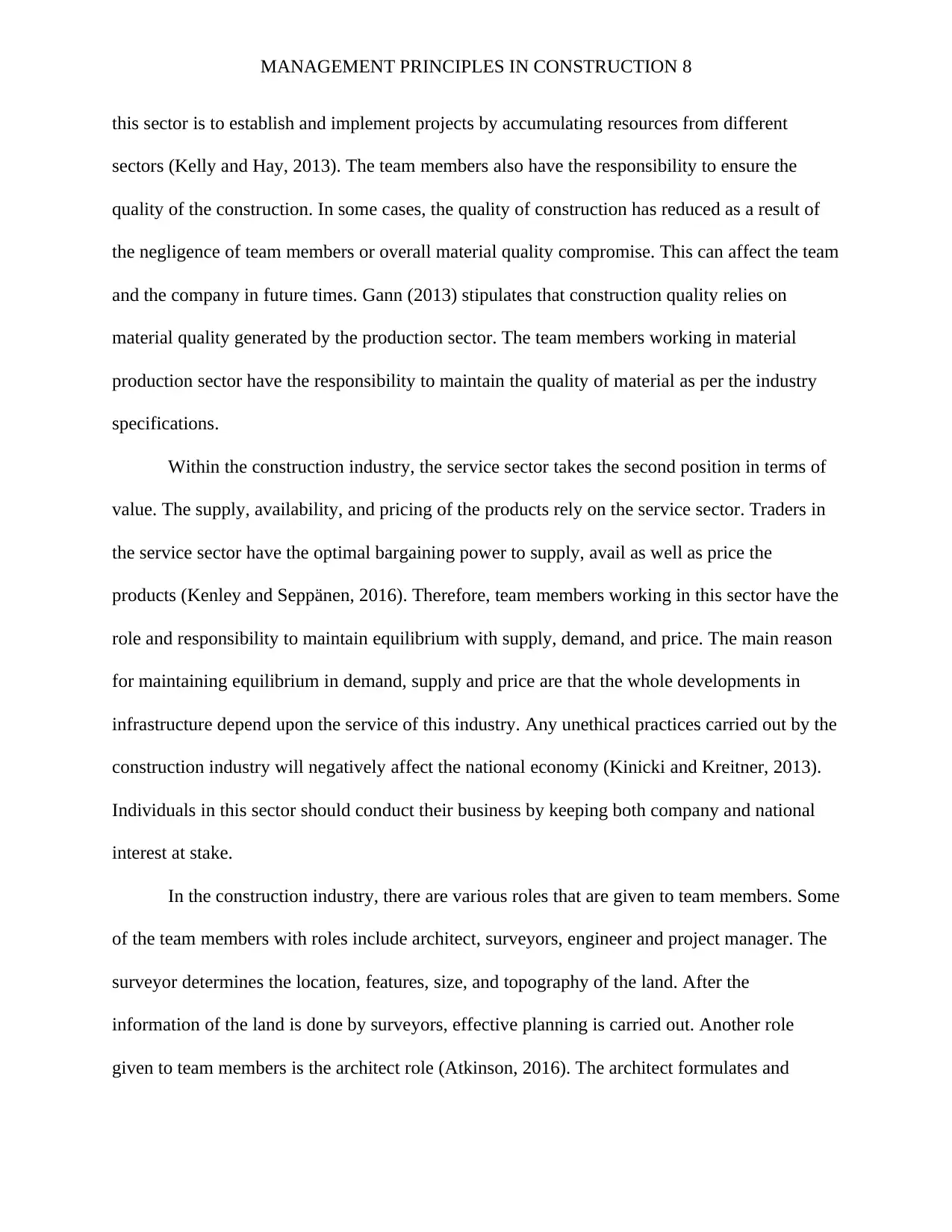
MANAGEMENT PRINCIPLES IN CONSTRUCTION 8
this sector is to establish and implement projects by accumulating resources from different
sectors (Kelly and Hay, 2013). The team members also have the responsibility to ensure the
quality of the construction. In some cases, the quality of construction has reduced as a result of
the negligence of team members or overall material quality compromise. This can affect the team
and the company in future times. Gann (2013) stipulates that construction quality relies on
material quality generated by the production sector. The team members working in material
production sector have the responsibility to maintain the quality of material as per the industry
specifications.
Within the construction industry, the service sector takes the second position in terms of
value. The supply, availability, and pricing of the products rely on the service sector. Traders in
the service sector have the optimal bargaining power to supply, avail as well as price the
products (Kenley and Seppänen, 2016). Therefore, team members working in this sector have the
role and responsibility to maintain equilibrium with supply, demand, and price. The main reason
for maintaining equilibrium in demand, supply and price are that the whole developments in
infrastructure depend upon the service of this industry. Any unethical practices carried out by the
construction industry will negatively affect the national economy (Kinicki and Kreitner, 2013).
Individuals in this sector should conduct their business by keeping both company and national
interest at stake.
In the construction industry, there are various roles that are given to team members. Some
of the team members with roles include architect, surveyors, engineer and project manager. The
surveyor determines the location, features, size, and topography of the land. After the
information of the land is done by surveyors, effective planning is carried out. Another role
given to team members is the architect role (Atkinson, 2016). The architect formulates and
this sector is to establish and implement projects by accumulating resources from different
sectors (Kelly and Hay, 2013). The team members also have the responsibility to ensure the
quality of the construction. In some cases, the quality of construction has reduced as a result of
the negligence of team members or overall material quality compromise. This can affect the team
and the company in future times. Gann (2013) stipulates that construction quality relies on
material quality generated by the production sector. The team members working in material
production sector have the responsibility to maintain the quality of material as per the industry
specifications.
Within the construction industry, the service sector takes the second position in terms of
value. The supply, availability, and pricing of the products rely on the service sector. Traders in
the service sector have the optimal bargaining power to supply, avail as well as price the
products (Kenley and Seppänen, 2016). Therefore, team members working in this sector have the
role and responsibility to maintain equilibrium with supply, demand, and price. The main reason
for maintaining equilibrium in demand, supply and price are that the whole developments in
infrastructure depend upon the service of this industry. Any unethical practices carried out by the
construction industry will negatively affect the national economy (Kinicki and Kreitner, 2013).
Individuals in this sector should conduct their business by keeping both company and national
interest at stake.
In the construction industry, there are various roles that are given to team members. Some
of the team members with roles include architect, surveyors, engineer and project manager. The
surveyor determines the location, features, size, and topography of the land. After the
information of the land is done by surveyors, effective planning is carried out. Another role
given to team members is the architect role (Atkinson, 2016). The architect formulates and
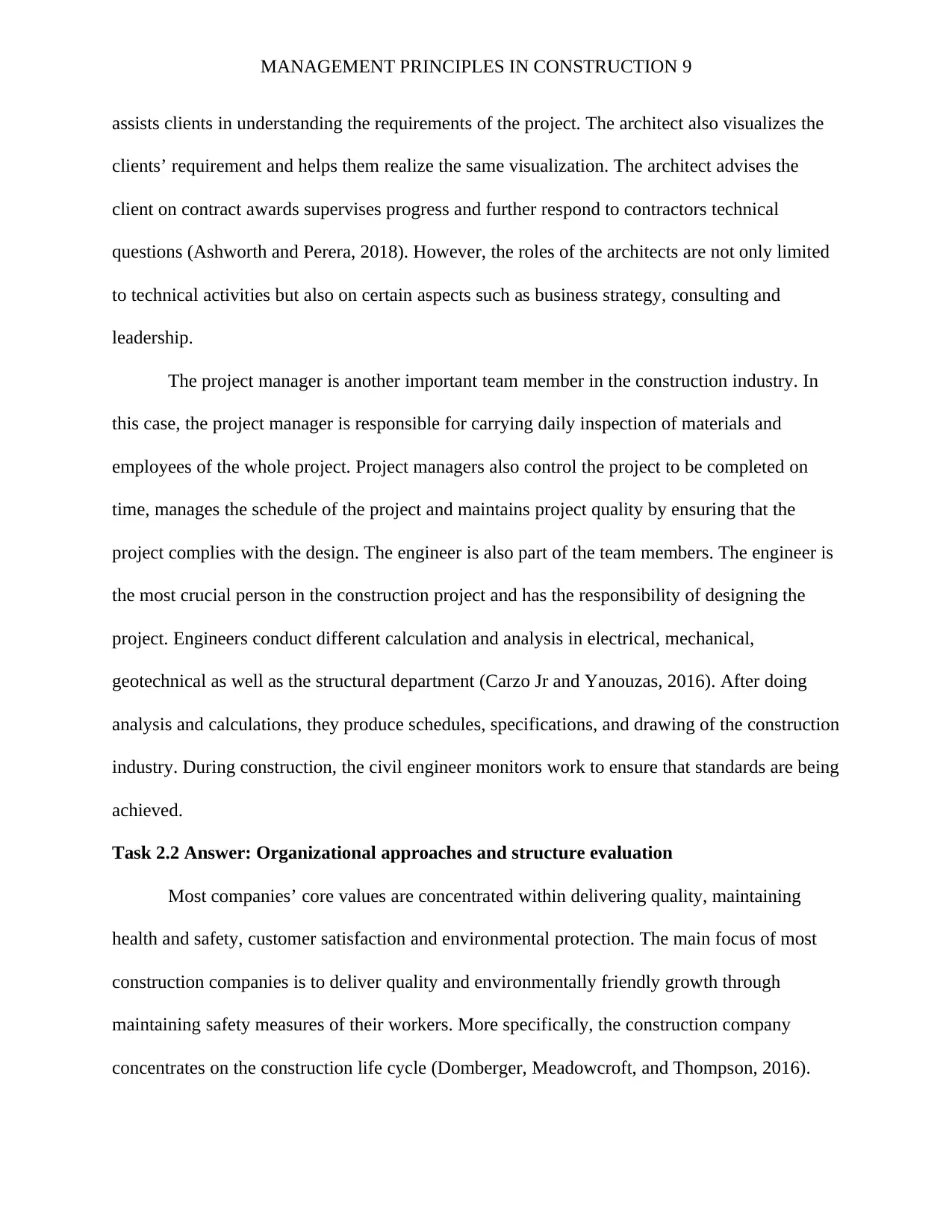
MANAGEMENT PRINCIPLES IN CONSTRUCTION 9
assists clients in understanding the requirements of the project. The architect also visualizes the
clients’ requirement and helps them realize the same visualization. The architect advises the
client on contract awards supervises progress and further respond to contractors technical
questions (Ashworth and Perera, 2018). However, the roles of the architects are not only limited
to technical activities but also on certain aspects such as business strategy, consulting and
leadership.
The project manager is another important team member in the construction industry. In
this case, the project manager is responsible for carrying daily inspection of materials and
employees of the whole project. Project managers also control the project to be completed on
time, manages the schedule of the project and maintains project quality by ensuring that the
project complies with the design. The engineer is also part of the team members. The engineer is
the most crucial person in the construction project and has the responsibility of designing the
project. Engineers conduct different calculation and analysis in electrical, mechanical,
geotechnical as well as the structural department (Carzo Jr and Yanouzas, 2016). After doing
analysis and calculations, they produce schedules, specifications, and drawing of the construction
industry. During construction, the civil engineer monitors work to ensure that standards are being
achieved.
Task 2.2 Answer: Organizational approaches and structure evaluation
Most companies’ core values are concentrated within delivering quality, maintaining
health and safety, customer satisfaction and environmental protection. The main focus of most
construction companies is to deliver quality and environmentally friendly growth through
maintaining safety measures of their workers. More specifically, the construction company
concentrates on the construction life cycle (Domberger, Meadowcroft, and Thompson, 2016).
assists clients in understanding the requirements of the project. The architect also visualizes the
clients’ requirement and helps them realize the same visualization. The architect advises the
client on contract awards supervises progress and further respond to contractors technical
questions (Ashworth and Perera, 2018). However, the roles of the architects are not only limited
to technical activities but also on certain aspects such as business strategy, consulting and
leadership.
The project manager is another important team member in the construction industry. In
this case, the project manager is responsible for carrying daily inspection of materials and
employees of the whole project. Project managers also control the project to be completed on
time, manages the schedule of the project and maintains project quality by ensuring that the
project complies with the design. The engineer is also part of the team members. The engineer is
the most crucial person in the construction project and has the responsibility of designing the
project. Engineers conduct different calculation and analysis in electrical, mechanical,
geotechnical as well as the structural department (Carzo Jr and Yanouzas, 2016). After doing
analysis and calculations, they produce schedules, specifications, and drawing of the construction
industry. During construction, the civil engineer monitors work to ensure that standards are being
achieved.
Task 2.2 Answer: Organizational approaches and structure evaluation
Most companies’ core values are concentrated within delivering quality, maintaining
health and safety, customer satisfaction and environmental protection. The main focus of most
construction companies is to deliver quality and environmentally friendly growth through
maintaining safety measures of their workers. More specifically, the construction company
concentrates on the construction life cycle (Domberger, Meadowcroft, and Thompson, 2016).
⊘ This is a preview!⊘
Do you want full access?
Subscribe today to unlock all pages.

Trusted by 1+ million students worldwide
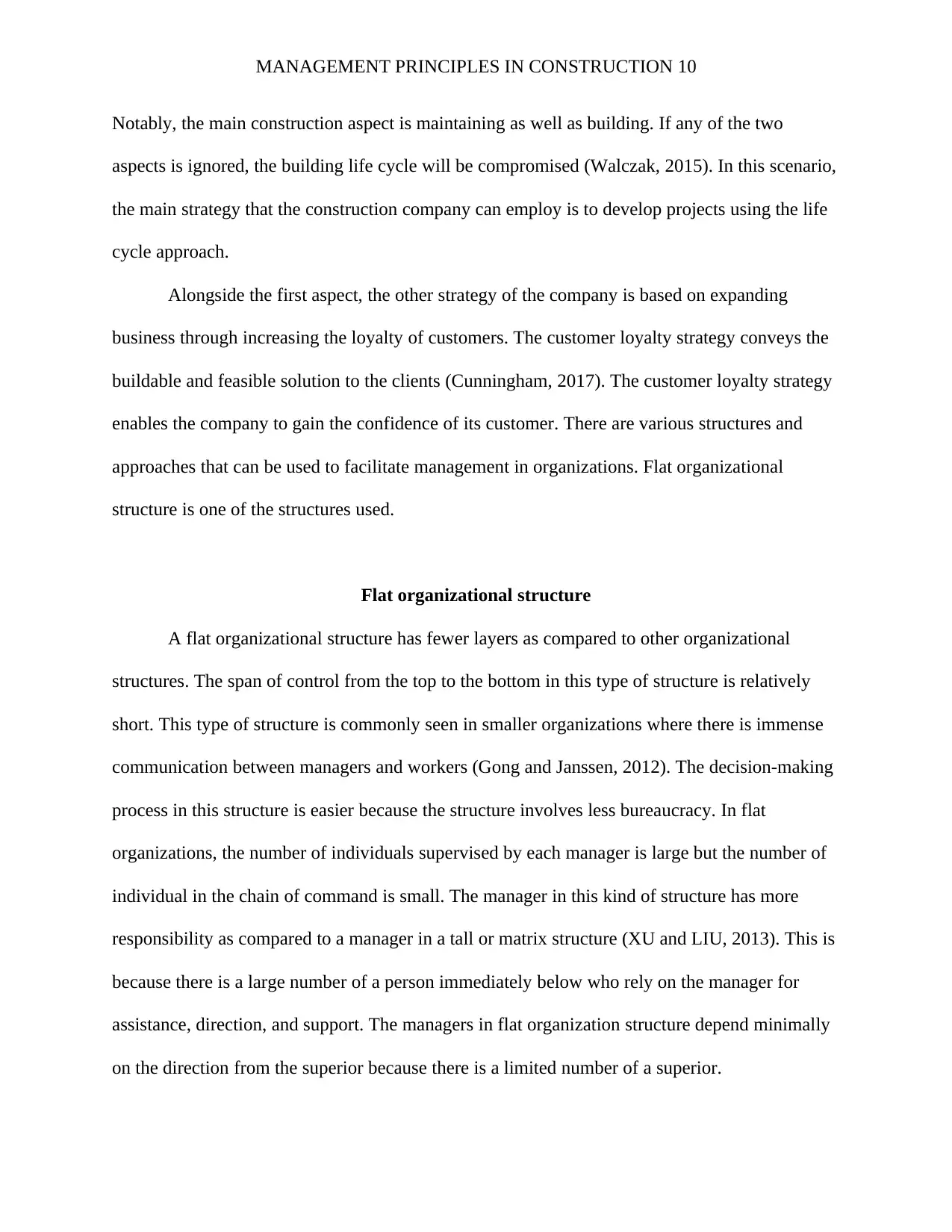
MANAGEMENT PRINCIPLES IN CONSTRUCTION 10
Notably, the main construction aspect is maintaining as well as building. If any of the two
aspects is ignored, the building life cycle will be compromised (Walczak, 2015). In this scenario,
the main strategy that the construction company can employ is to develop projects using the life
cycle approach.
Alongside the first aspect, the other strategy of the company is based on expanding
business through increasing the loyalty of customers. The customer loyalty strategy conveys the
buildable and feasible solution to the clients (Cunningham, 2017). The customer loyalty strategy
enables the company to gain the confidence of its customer. There are various structures and
approaches that can be used to facilitate management in organizations. Flat organizational
structure is one of the structures used.
Flat organizational structure
A flat organizational structure has fewer layers as compared to other organizational
structures. The span of control from the top to the bottom in this type of structure is relatively
short. This type of structure is commonly seen in smaller organizations where there is immense
communication between managers and workers (Gong and Janssen, 2012). The decision-making
process in this structure is easier because the structure involves less bureaucracy. In flat
organizations, the number of individuals supervised by each manager is large but the number of
individual in the chain of command is small. The manager in this kind of structure has more
responsibility as compared to a manager in a tall or matrix structure (XU and LIU, 2013). This is
because there is a large number of a person immediately below who rely on the manager for
assistance, direction, and support. The managers in flat organization structure depend minimally
on the direction from the superior because there is a limited number of a superior.
Notably, the main construction aspect is maintaining as well as building. If any of the two
aspects is ignored, the building life cycle will be compromised (Walczak, 2015). In this scenario,
the main strategy that the construction company can employ is to develop projects using the life
cycle approach.
Alongside the first aspect, the other strategy of the company is based on expanding
business through increasing the loyalty of customers. The customer loyalty strategy conveys the
buildable and feasible solution to the clients (Cunningham, 2017). The customer loyalty strategy
enables the company to gain the confidence of its customer. There are various structures and
approaches that can be used to facilitate management in organizations. Flat organizational
structure is one of the structures used.
Flat organizational structure
A flat organizational structure has fewer layers as compared to other organizational
structures. The span of control from the top to the bottom in this type of structure is relatively
short. This type of structure is commonly seen in smaller organizations where there is immense
communication between managers and workers (Gong and Janssen, 2012). The decision-making
process in this structure is easier because the structure involves less bureaucracy. In flat
organizations, the number of individuals supervised by each manager is large but the number of
individual in the chain of command is small. The manager in this kind of structure has more
responsibility as compared to a manager in a tall or matrix structure (XU and LIU, 2013). This is
because there is a large number of a person immediately below who rely on the manager for
assistance, direction, and support. The managers in flat organization structure depend minimally
on the direction from the superior because there is a limited number of a superior.
Paraphrase This Document
Need a fresh take? Get an instant paraphrase of this document with our AI Paraphraser
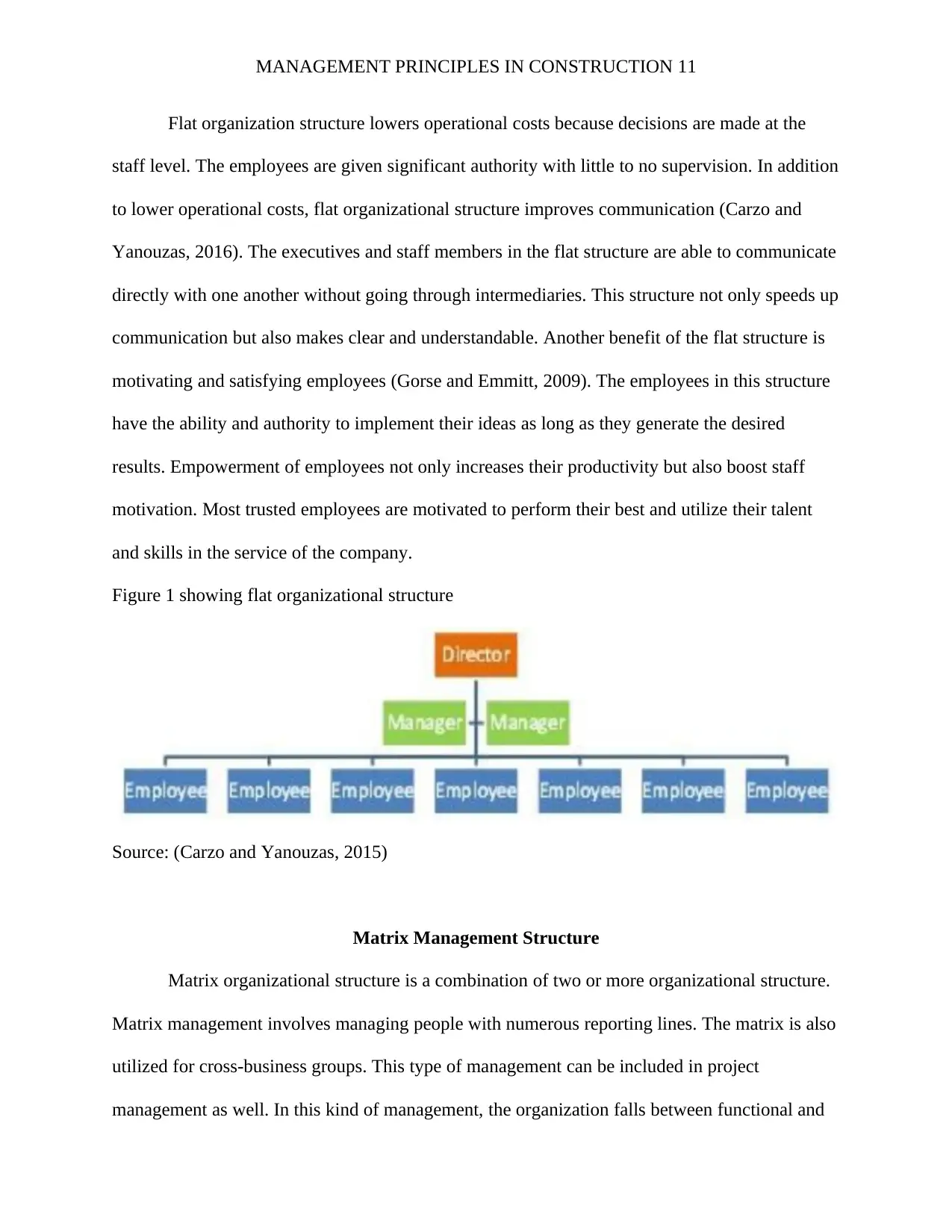
MANAGEMENT PRINCIPLES IN CONSTRUCTION 11
Flat organization structure lowers operational costs because decisions are made at the
staff level. The employees are given significant authority with little to no supervision. In addition
to lower operational costs, flat organizational structure improves communication (Carzo and
Yanouzas, 2016). The executives and staff members in the flat structure are able to communicate
directly with one another without going through intermediaries. This structure not only speeds up
communication but also makes clear and understandable. Another benefit of the flat structure is
motivating and satisfying employees (Gorse and Emmitt, 2009). The employees in this structure
have the ability and authority to implement their ideas as long as they generate the desired
results. Empowerment of employees not only increases their productivity but also boost staff
motivation. Most trusted employees are motivated to perform their best and utilize their talent
and skills in the service of the company.
Figure 1 showing flat organizational structure
Source: (Carzo and Yanouzas, 2015)
Matrix Management Structure
Matrix organizational structure is a combination of two or more organizational structure.
Matrix management involves managing people with numerous reporting lines. The matrix is also
utilized for cross-business groups. This type of management can be included in project
management as well. In this kind of management, the organization falls between functional and
Flat organization structure lowers operational costs because decisions are made at the
staff level. The employees are given significant authority with little to no supervision. In addition
to lower operational costs, flat organizational structure improves communication (Carzo and
Yanouzas, 2016). The executives and staff members in the flat structure are able to communicate
directly with one another without going through intermediaries. This structure not only speeds up
communication but also makes clear and understandable. Another benefit of the flat structure is
motivating and satisfying employees (Gorse and Emmitt, 2009). The employees in this structure
have the ability and authority to implement their ideas as long as they generate the desired
results. Empowerment of employees not only increases their productivity but also boost staff
motivation. Most trusted employees are motivated to perform their best and utilize their talent
and skills in the service of the company.
Figure 1 showing flat organizational structure
Source: (Carzo and Yanouzas, 2015)
Matrix Management Structure
Matrix organizational structure is a combination of two or more organizational structure.
Matrix management involves managing people with numerous reporting lines. The matrix is also
utilized for cross-business groups. This type of management can be included in project
management as well. In this kind of management, the organization falls between functional and
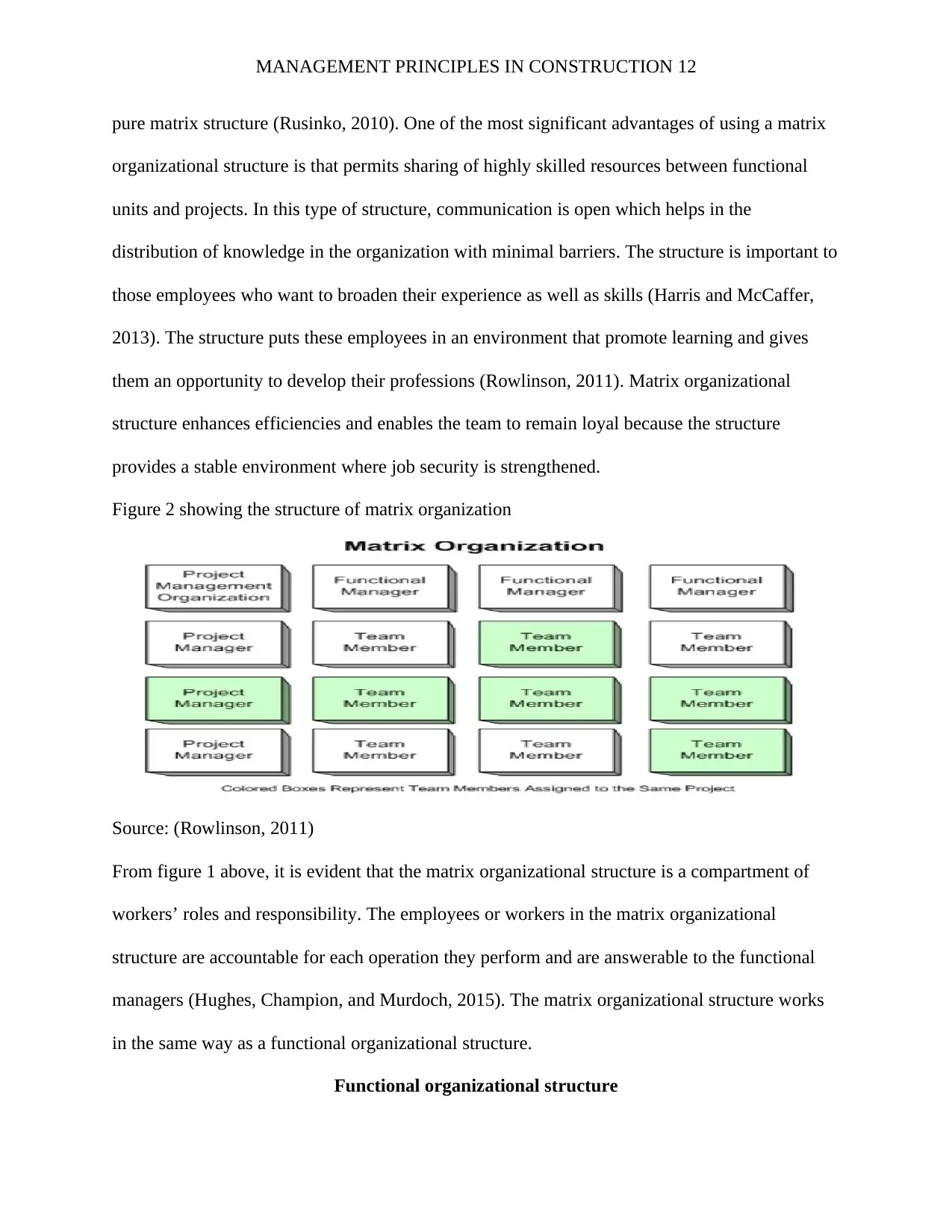
MANAGEMENT PRINCIPLES IN CONSTRUCTION 12
pure matrix structure (Rusinko, 2010). One of the most significant advantages of using a matrix
organizational structure is that permits sharing of highly skilled resources between functional
units and projects. In this type of structure, communication is open which helps in the
distribution of knowledge in the organization with minimal barriers. The structure is important to
those employees who want to broaden their experience as well as skills (Harris and McCaffer,
2013). The structure puts these employees in an environment that promote learning and gives
them an opportunity to develop their professions (Rowlinson, 2011). Matrix organizational
structure enhances efficiencies and enables the team to remain loyal because the structure
provides a stable environment where job security is strengthened.
Figure 2 showing the structure of matrix organization
Source: (Rowlinson, 2011)
From figure 1 above, it is evident that the matrix organizational structure is a compartment of
workers’ roles and responsibility. The employees or workers in the matrix organizational
structure are accountable for each operation they perform and are answerable to the functional
managers (Hughes, Champion, and Murdoch, 2015). The matrix organizational structure works
in the same way as a functional organizational structure.
Functional organizational structure
pure matrix structure (Rusinko, 2010). One of the most significant advantages of using a matrix
organizational structure is that permits sharing of highly skilled resources between functional
units and projects. In this type of structure, communication is open which helps in the
distribution of knowledge in the organization with minimal barriers. The structure is important to
those employees who want to broaden their experience as well as skills (Harris and McCaffer,
2013). The structure puts these employees in an environment that promote learning and gives
them an opportunity to develop their professions (Rowlinson, 2011). Matrix organizational
structure enhances efficiencies and enables the team to remain loyal because the structure
provides a stable environment where job security is strengthened.
Figure 2 showing the structure of matrix organization
Source: (Rowlinson, 2011)
From figure 1 above, it is evident that the matrix organizational structure is a compartment of
workers’ roles and responsibility. The employees or workers in the matrix organizational
structure are accountable for each operation they perform and are answerable to the functional
managers (Hughes, Champion, and Murdoch, 2015). The matrix organizational structure works
in the same way as a functional organizational structure.
Functional organizational structure
⊘ This is a preview!⊘
Do you want full access?
Subscribe today to unlock all pages.

Trusted by 1+ million students worldwide
1 out of 37
Related Documents
Your All-in-One AI-Powered Toolkit for Academic Success.
+13062052269
info@desklib.com
Available 24*7 on WhatsApp / Email
![[object Object]](/_next/static/media/star-bottom.7253800d.svg)
Unlock your academic potential
© 2024 | Zucol Services PVT LTD | All rights reserved.





